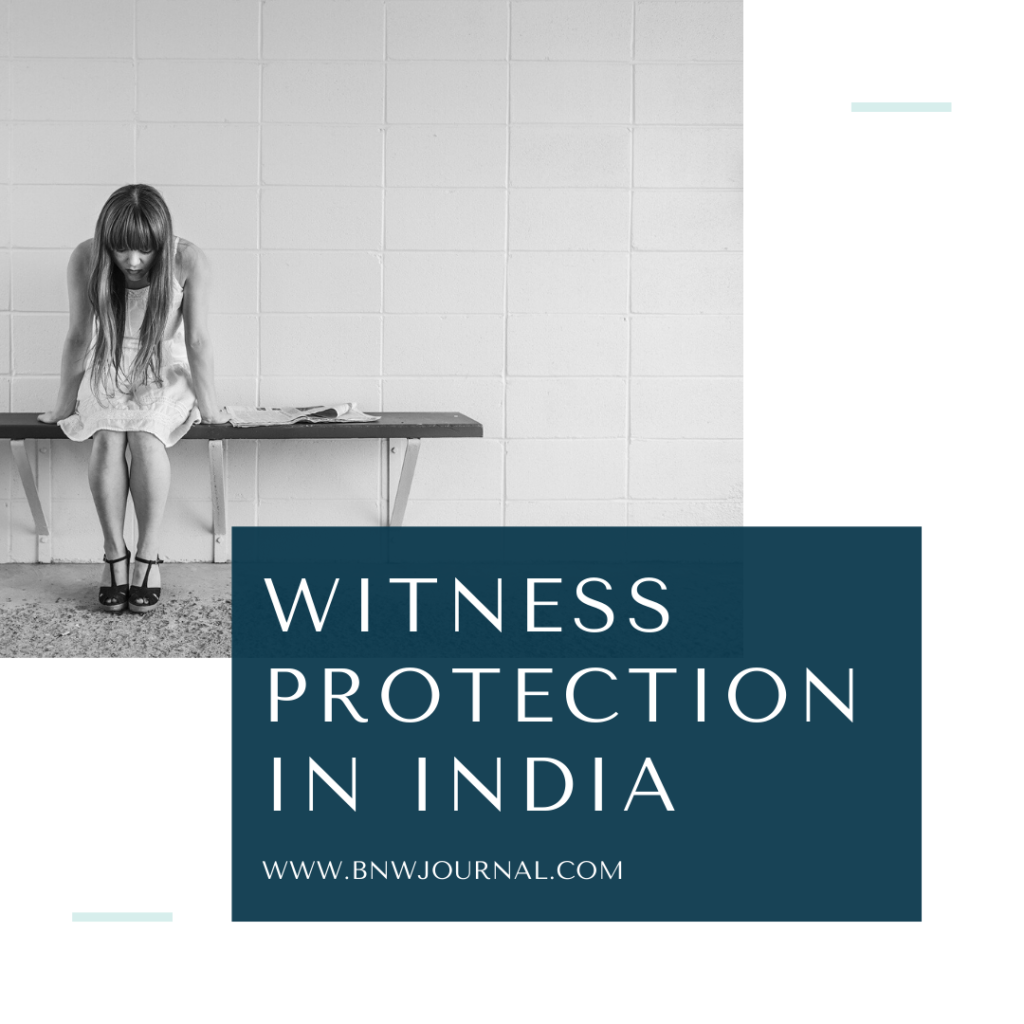![]()
Introduction
Witness is a significant constituent in the criminal justice system. By giving proper evidence, the witness provides substance to the court to discover the truth and arrive at an upright conclusion. In the primary sense of the word, a witness is a person who has knowledge of an event.

Meaning and Significance
As the most direct mode of acquiring knowledge of an event is by seeing it, ‘witness’ has acquired the sense of a person who is present at and observes a transaction. Jeremy Bentham, an English Philosopher once said, “Witnesses are eyes and ears of the Courts”. And thus it becomes crucial for the state to ensure sufficient protection and security to the person before the court of law. Before, during and after a trial.
Some extraneous elements in the form of threats possess the capability to alter the stance of the witness over a certain case. Consequently, intervening with the fair administration of justice. Hence, it comes imperative upon the state to bring in some law to provide security to the witnesses. Several countries including India, have a scheme related to witness protection. However, in this article we shall only discuss the scheme related to witness protection in India.
Background of the Witness Protection Scheme in India
On 6th December 2018, the Hon’ble Supreme Court of India approved the draft witness protection scheme. It is formulate by the Government of India. This draft was prepared by inviting suggestions from police personnel, eight States/Union Territories, and three high courts. Lastly, it was finalized by the National Legal Services Authority (NALSA). This seal of approval of the Supreme Court of India was in response to a petition that sought security for witnesses in the rape cases; involving Asaram Bapu. The bench of the Supreme Court of India comprising Justice A.K Sikri and Justice Abdul Nazeer held; “The right to testify in courts in a free and fair manner without any pressure and threat whatsoever is under serious attack today.
If one is unable to testify in courts due to threats or other pressures, then it is a clear violation of Article 21 of the Constitution.” Furthermore, “The right to life guaranteed to the people of this country also includes in its fold the right to live in a society, which is free from crime and fear, and the right of witnesses to testify in courts without fear or pressure.” The Hon’ble Court further held, “it shall be the ‘law’ under Article 141/142 of the Constitution, till the enactment of suitable Parliamentary and/or State Legislations on the subject”.
Provisions in Indian legal system for the protection of witnesses before the Witness Protection Scheme & Need for the introduction of Witness Protection laws in India
Previously, there did not exist any law in India which guaranteed protection to the witness. However, there are certain specific provisions under Indian laws guaranteeing protection to the witness. For instance, section 17 of the N.I.A. Act, 2008, provided security to a witness if he is feeling physically threatened while making an application during the trial. Similarly, Section 195A of the Code of Criminal Procedure provides the facility to a witness to lodge a complaint. In the case he/she is being threaten.
However, improper implementations led to the failure of the administration in according to security to the witnesses. Since there was not any proper provision of law with respect to the protection of witnesses. The same continue to be a grey area of the Criminal justice system in India. The need for a proper scheme to protect the witnesses was first highlight by the Hon’ble Supreme Court of India in Zahira Habibullah H. Sheikh and Another v. State of Gujarat, wherein while defining the term, ‘fair trial’; the hon’ble court held that, “If the witnesses get threatene or are force to give false evidence. That also would not result in fair trial”.
However, it was the 14th Report of Law Commission in 1958 which first presented the need to protect witnesses. Under the same, ‘witness protection’ was looked and considered from a different angle altogether. It read, “inadequate arrangements for witnesses in the Courthouse, the scales of traveling allowance and daily batta (allowance) paid for witnesses for attending the Court in response to a summons from the Court.” In 1996, the 154th Report of Law Commission; spell out the inconvenience and threat face by a witness from the accused. Further, the 172nd and 178th reports; also emphasize the question of protection of witnesses from the threats of the accused. Keeping in view the aforesaid reports and judgment of the Hon’ble Supreme Court. The Witness Protection Scheme, 2018 devise by NALSA & BPR&D.
Set Procedure for filing an application for the security and protection of witness as defined under the Witness Protection Scheme
The Witness Protection Law defines a set-procedure for filing and processing the application for the security and protection of witnesses. Firstly, an application form attach in Annexure 1 is need to be file by the applicant seeking protection. It is before the competent authority. It must have territorial jurisdiction along with supporting documents through the Superintendent of Police or at the time of the trial. On receipt of the application by the competent authority, the Commissionerate will formulate a Threat Analysis Report. With information mentione therein store confidentially and the same shall be forward to the competent authority within five working days. However, in case any urgency where there is an imminent threat to the witness and his family; an interim order can be pass.
The aforesaid threat analysis report shall contain the perception of the threat level. Also the suggestive measures for providing adequate protection to the witness and his family. Furthermore, the hearings in the matter shall be held in-camera confidentially by the competent authority.
Lastly, the overall implementation of the witness protection order is to be made by the head of the Police. Basically of the concerned State or Union Territory. Also, in the case there is a need to revise the Witness Protection order previously pass. The same shall be forward by the Competent authority to the Commissioner of Police. It is to to draft a Fresh Threat Analysis Report.
Relation between the security provided and the level of threat perceived by the witness
It is to be note that the security provide to the witness shall be directly proportional to the level of threat perceive. There are three categories mentioned under the said scheme based upon the level of threat perception. The Category ‘A’ talks about the threat extend to the life of witness or his family. And consequently affecting their normal daily way of life. While, category ‘B’ highlights the threat extended to the safety and reputation of the witness. Lastly, category ‘C’ talks about moderate threat that extends to harassment and intimidation. Among all, category ‘A’ has been regard as the gravest form of threat. Because the same might its presence even after the completion of trials or investigation.
Some Major limitations of the Witness Protection Scheme in India
Notwithstanding the fact that the scheme offers a breathing space to the witness by rendering the same protection during a trial, it suffers from major limitations. Firstly, the time frame of three months for the protection of the witness is redundant as it is risky to eliminate the possibility of threat from the accused once the protection terminates. The protection of the witness must be until the threat ceases to exist. Secondly, investing a corrupt administrative system with the authority to categorize witnesses according to the level of threat perceive is dangerous, as there are chances that the latter being categorize falsely.
Furthermore, since the task of formulating the threat analysis report has to the police department. Therefore in high profile cases, the same can be pressurize to apprise the accused with the information regarding the witness. Lastly, the absence of any provision penalizing the violation of the scheme’s commitment to maintain the confidentiality of the witness reduces the potency of the same. It is imperative to have an effective disincentive to avert the disclosure of such confidential information.
Conclusion
To conclude, it is imperative upon the state to protect the witness from the threat of accused by protecting his identity and not disclosing confidential information related to him. India, however has now a law to protect the witness but few limitations are disturbing the course of justice. It is significant to have foolproof mechanisms to address the issue related to witness protection because corrupt administration and improper management might make the witnesses hostile.



0 Comments